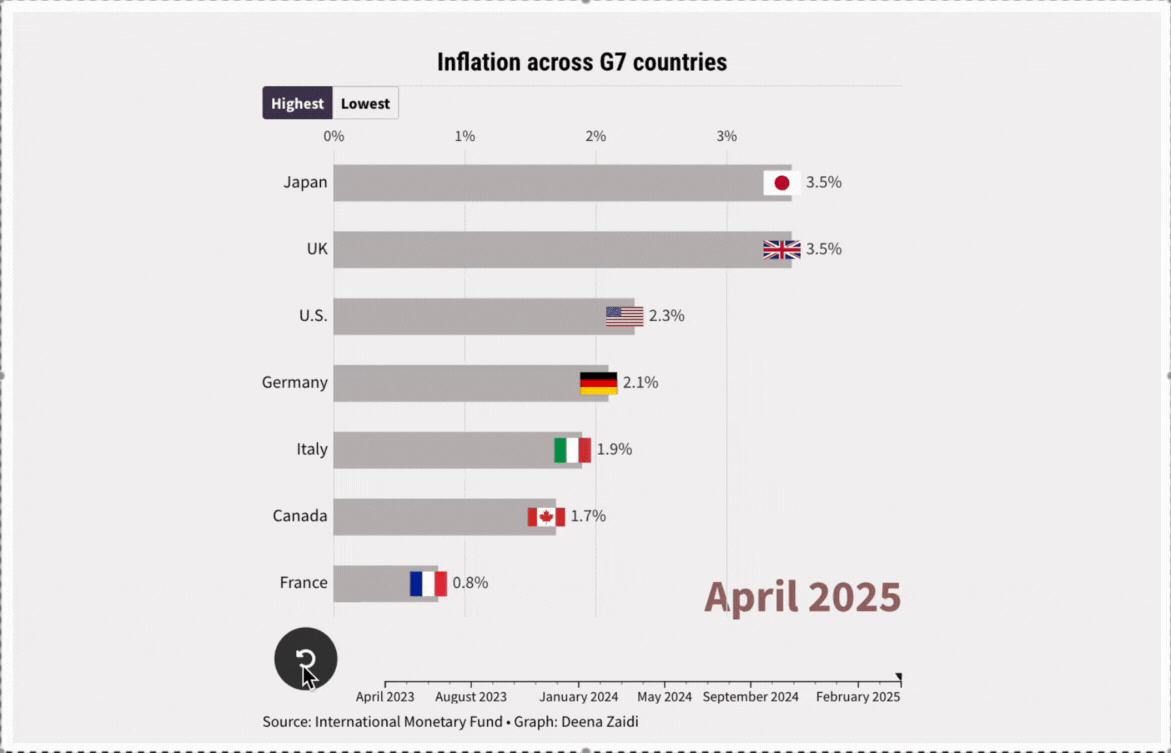The ideal way to calculate inflation across G7 would be using Eurostat’s harmonized index of consumer prices (HICP), which ensures cross-country consistency, but the data remains unavailable for countries such as Canada and Japan.
While the U.S. has attempted to track this rate to make comparisons easy, the update has been sporadic and not widely adopted.
So for the purpose of this story, I’ve relied on actual consumer price indices (CPIs) provided by each country to get a rough snapshot of inflation trends and compared them to the overall G7 inflation rate provided by the Organization for Economic Co-operation and Development (OECD).
Compared to March 2025, annual inflation declined for most G7 nations, remained stable in two, and rising for one.
According to recent data for April, the U.S. reported a 2.3% inflation rate, slightly above the Federal Reserve’s 2% target. This moderate level suggests that the Fed’s monetary tightening efforts are having some effect, though tariff effects are yet to be fully captured in consumer prices.
Other G7 nations are also saw slower inflation, with Canada‘s inflation cooling to 1.7% in April, down from 2.3% in March. Bank of Canada aims to keep inflation at the 2% midpoint of an inflation-control target range of 1 to 3%.
UK: 3.5%, up from 2.6% in March—the highest headline rate since early 2024, and the only G7 country where CPI rose month-on-month.
Germany: Europe’s largest economy by GDP—2.1%, down from 2.2% in March. Falling energy costs pulled April’s inflation lower, but rising food prices offset some of that decline.
Italy: 1.9%, unchanged. Italy’s rate remains at an 18-month high, extending the “normalization” of consumer prices after the energy and food shocks following Russia’s invasion of Ukraine.
France: remains stagnant at 0.8% and is below European Central Bank’s 2% target—which perhaps is a sign of continued economic sluggishness in the region.
Japan: the only Asian economy in G7, core inflation rose at its fastest annual pace in over two years, climbing to 3.5% in April, according to data released Friday, increasing the likelihood of another interest rate hike before the end of the year. The Japanese yen strengthened 0.15% against the U.S. dollar following the data release. The country is also one of the hardest hit by Trump’s 25% tariff on auto, steel and aluminum products.
Below is a graph which captures the inflation rates of every G7 nation from April 2020 to April 2025.
According to the International Monetary Fund (IMF), the average inflation rate for advanced economies is projected at 2.5%, while emerging markets and developing economies are expected to experience a higher average of 5.5%.
Much of the tariff impact has yet to be fully reflected in consumer prices, and for many central banks, this uncertainty could prompt a pause on further interest rate moves as they wait to assess the full inflationary fallout.
